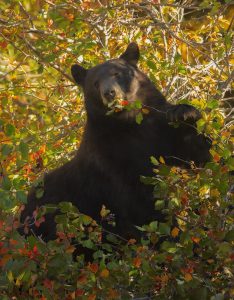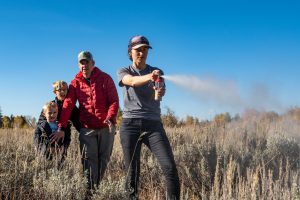If you live and recreate in Idaho, you’re in bear country. Idaho is home to both black and grizzly bears, so it’s important for both recreationists and people that live in areas with bears to know how to handle a bear encounter – and how to avoid encounters in the first place.
It’s that time of year again when bears are out of hibernation and active – bears are active from April 1st to November 30th. If you’re a homeowner, farmer, rancher, recreationist, hunter or public land user, it’s important to take steps to reduce the risk of conflicts between people and bears.
If you live in an area with bears, take these precautions to keep your families, livestock and pets safe. 
- Store trash, pet food, and other bear attractants in a secure location such as your garage or shop.
- Use electric fencing to keep bears out of livestock pens, beehives, gardens, orchards, berry patches and compost piles. Pick fruits immediately when ripened. Bring in/secure livestock and pet feed at night.
- Dispose of dead livestock through sanitation services or inside a boneyard that is protected by electric fencing.
- Keep grills and barbecues clean of food and grease. Store them in a secure location such as your garage or shop when you are not using it.
- Bring pets inside at night.
- Keep car doors and windows closed.
- Put bird feeders away until December 1st.
- Purchase and learn how to use bear spray.
- Do not feed bears!
If you are recreating in bear country, follow these tips:
- Bring your friends! Hike, camp, adventure in groups of 2 or more. 63% of bear attacks world-wide between 2000 and 2015 occurred when the victim was alone.
- Make noise! Most bear attacks are defensive, and bears are less likely to get near humans if they know they’re there. Making noise is especially important near streams or dense vegetation where it might be harder for a bear to notice your approach. If you’re alone, aim to shout something like, “Hey, bear!” at least once every 2-3 minutes.
- Properly store attractants! Store food, personal hygiene products, trash, and other attractants in a bear-resistant canister. You can also hang your attractants using the Pacific Crest Trail method. Store attractants at least 100 yards away from trails and campsites. Do not sleep with or burn any attractants! This includes personal hygiene items like your toothpaste, lotions – anything with a scent.
- Keep dogs leashed! Dogs that are unleashed may run ahead on the trail and come across an unsuspecting bear. You don’t want your dog to have that encounter, or have that bear chase the dog back to you. Keeping your dog leashed is the best way to prevent any accidental conflicts.
- Carry bear spray! Bear spray is more effective than a firearm at deterring bears. Check your spray’s expiration date before you go, and make sure that your bear spray is accessible while you’re out — not tucked away in a backpack. Spray low, in one sweeping motion in front of you, and be aware of the direction of the wind so that the spray doesn’t immediately waft back to you.

Bears usually do not want to encounter you any more than you want to encounter them. By planning ahead and preparing, knowing the area, and practicing these bear aware behaviors, you can lessen the chances of encountering a bear on your next hike or camping trip. Living and recreating in bear country comes with responsibility. By educating ourselves and taking preventative measures, we can avoid conflict between people and bears – ensuring enough room and safety for people and bears alike.
To stay updated on information regarding Idaho’s wildlife, sign up for our Wildlife Program email updates!

